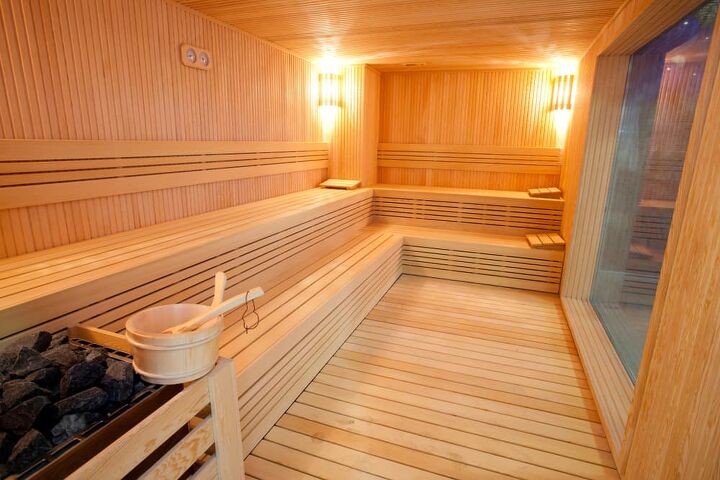How To Build A Sauna In Your House (Quickly & Easily!)

Building a home sauna can be a challenging yet immensely rewarding experience. The planning and building of a home sauna take above-average skill. However, many homeowners successfully add a sauna to their homes. Many other homeowners wonder how to build a home sauna
Building a home sauna is much like any other construction project. You are essentially adding another structure to your property. You need a plan that shows you the details. You may need a permit which will require inspections and using licensed contractors for some parts of the job. Finally, you need to have the self-confidence to undertake the job.
A complete step-by-step guide is beyond the scope of this article. However, we can give you a general understanding of the steps you should take before driving the first nail. Planning and preparation is the key to success with any construction project. Lets’ get on with planning your sauna.
Do You Need Handyman Services?
Get free, zero-commitment quotes from pro contractors near you.

Have a Plan – The Road Map to Success
Before you begin any trip, you need to know your destination. Only by understanding where you are going can you hope to find the best route. Building a sauna is not much different. If you have a clear understanding of what is at the end of the road, you can plan the best way to navigate the path to a successful build.
What Style of Sauna do You Want?
Before going any further, exactly what kind of sauna do you want? The type of sauna you build directly affects the plans you need and the equipment that will go into your sauna. There are three styles of saunas
Dry Saunas
Dry saunas are exceedingly popular. The core of a dry sauna is a special stove that heats rocks to raise the sauna’s interior to the desired temperature. The stove and rocks may allow you to pour water over the rocks to add humidity to the air.
Turkish Sauna or Steam Room
Steam rooms or Turkish saunas use moist heat to raise the temperature of the sauna. Many people consider the hot moist atmosphere inside a Turkish sauna a therapeutic environment. The detoxification of the body by the wet heat is the goal of using a steam room.
Infrared Sauna
Infrared saunas are a recent addition to the sauna trend. A specialized heating unit uses infrared rays to heat your body and induce sweating. This type of heating gives you a deep relaxing heat the penetrates the muscles inducing relaxation. Many people who exercise intensely swear that an infrared sauna reduces muscle soreness.
With the What Decided, Now the Where
After you decide what kind of sauna you want, the next question that needs an answer is where the sauna will go. You face several options for this decision.
In the House
If you have the room to spare, you can put your sauna in your house. Putting a sauna in your house is convenient and can lessen the overall cost of a sauna installation. Most of the heavy construction work is complete. There are even kits that are custom created to fit an existing space.
On the Patio
An existing patio is a convenient place to put a sauna. Many people add a patio sauna close to their hot tub. Placing a sauna on a patio that has an existing roof is much less complicated than other projects. Often plumbing and electrical connections are close by and easy to access.
Stand-Alone Installation
Building a stand-alone sauna is an ambitious project. You are creating a whole new structure with all the requirements, including a foundation, weather-tight roof, and utility connections. A stand-alone sauna is the most difficult type of sauna to design, build, and install. Most homeowners will hire a contractor with sauna experience at this level.
The Plan – Creating the Roadmap to Your Finished Project
The first part of any construction project is a plan. The plan is your roadmap to a successfully completed project. When it comes to plans, you have several options.
Buy a Kit
There are literally hundreds of pre-built kit saunas available. These kits range from saunas designed to fit into an existing room in your house to stand-alone structures for your backyard or patio. Kits are a good choice for someone with limited construction experience or time. They generally are easy to put together and go together quickly.
You need to shop carefully. Like anything else, there are levels of quality. Surprisingly, price is not a particularly good reflection of quality. If you decide that a kit is a better choice for you, find a local dealer who has experience with several brands. These dealers know which brands of sauna give the fewest problems.
Buy a Plan
If you are intent on building your sauna, consider purchasing a complete plan. A quick search of the internet returns an overwhelming number of options for sauna plans. We have a few quick notes about sauna plans.
- If the plans are for a stand-alone outdoor sauna, be sure the plans include the necessary drawings to file for a building permit if it is necessary. Your building permit department can tell you what plans they need to issue a permit.
- The sauna plans should include a detailed list of materials and parts.
- If possible, buy pre-printed drawings. Many companies will send you a set of PDF files with the actual drawings. Printing the drawings requires finding someone with a large format printer to produce the actual drawings that the permit department, sub-contractors, and inspectors will need. Printing many pages of plans can get expensive. It is almost impossible to work from plans printed on standard size paper.
- Be sure the plans are complete. If your dream sauna has electricity (it almost surely will), there should be electrical plans. You may have water running to your sauna, so plumbing plans are a must.
Design Your Own
Creating your sauna design can be undeniably satisfying. Taking a project from an idea in your head, putting it on paper, and then watching the design unfold during construction is magical. However, creating the construction plans can be more difficult than the actual build. Not many of us have the talent or the skills to create blueprints.
Walking into the local building permit office with sketches drawn on notebook paper probably won’t get you far. Even if you don’t need a permit, starting a project of this scale without detailed plans is a recipe for disaster.
Materials and Equipment
Once you have your plan, it is time to consider what kind of materials to use in the construction. Choosing the equipment to install in your sauna is another decision to make before you begin construction. Having everything on hand before you make a cut or drive a screw is important.
If you elect to purchase a kit, the choice of materials and equipment is complete. Most kits come with everything to install or build your sauna. The material should be precut to size and clearly labeled. From here, it is just a matter of following the directions and assembling the parts.
When you have your plan, the biggest decisions are what kind of wood and other materials you will use. These decisions are critical. The type of material you used to construct your sauna will dictate how easy it is to maintain and how long it will last. There are some considerations when choosing wood for your sauna project.
Heat and Humidity
Saunas get hot. Some saunas approach 150 degrees Fahrenheit. The wood you choose must be dense enough to stand this kind of heat without warping or splitting.
Chose the Wood Carefully
Wet saunas like steam rooms or Turkish saunas experience extremes in humidity as well as heat. The wood chosen for a wet sauna must be resistant to moisture as well as mold and mildew.
Some popular choices of wood for sauna construction include
- Cedar – Cedar is probably the most popular choice for sauna builds. Cedar not only has a beautiful look, but it also has a pleasant smell, especially when heated. Benches made of cedar tend to remain cooler and more comfortable when the sauna is at operating temperature.
- Basswood – Another popular choice for sauna construction is basswood. One downside to basswood is its tendency to shrink if it isn’t aged properly before use. If you choose basswood, make sure that the lumber has been aged and allowed to cure completely.
- Popular – Poplar is a staple in the lumber industry but is seldom used for finished projects. However, it is economical and is considered hardwood. It is durable, stable, and easy to work. Not as attractive as other woods, popular can be stained for a more attractive appearance.
- Hemlock – Hemlock is another utility wood suitable for sauna construction. Hemlock is probably the most budget-friendly wood on our list. If material cost is a concern, you should consider using hemlock for most of your construction.
The Heart of the Sauna – The Heater
Selecting a heater or stove for your sauna can be as daunting as choosing a design or a location. Not only do you have to choose the style of sauna heater, but you must decide on the fuel as well. There are pros and cons to each fuel option.
Electric Sauna Heaters – The Most Popular Option
Most saunas built in the United States are electric. These are the most economical to purchase, install and operate. The sizes range from small home sauna heaters to large commercial heaters used in gyms and clubs.
Electricity as a fuel source for a sauna heater makes sense in many ways. Electric heaters don’t need vents like gas heaters or wood-burning heaters. There are no toxic fumes created, nor do they require constant attention when operating.
Operating an electric sauna heater requires no more skill than flipping a switch. It is no wonder that most people opt for an electric sauna heater.
Gas-Fired Heaters – Economical but More Complex
Sauna heaters that use natural gas or propane are available. Most people who choose a gas-fueled sauna heater live in areas when electrical power is limited to non-existent. Gas-fueled sauna heaters are expensive to purchase and install.
The gas combustion in the heater creates toxic fumes requiring a vent to the outside of the sauna enclosure. Installing a gas-fueled sauna heater must be done by a licensed plumber and under recognized building codes. Anything less can lead to tragic consequences.
Gas-fired sauna heaters, because of the complex nature of the controls, safety features, and construction, are typically much more expensive than electric heaters of comparable size.
Wood-Burning Sauna Heaters – The Traditionalist Choice
If you are a purist when it comes to saunas, a wood-burning sauna heater fits the bill. Saunas have a long tradition in the Nordic countries, and wood was the only heat source for centuries. Modern wood-burning sauna heaters are a far cry from their ancient relatives.
You can still get sauna heaters that burn split wood, much like those that have heated saunas for centuries. The installation of these wood-burners has the same requirements as a gas-fueled sauna heater. You must install a vent stack to carry away the smoke and toxic gases
Wood-burning sauna heaters are less efficient than either electric or gas-fired models. Much of the heat goes up the vent stack with the smoke. Also, the sauna’s heating tends to be uneven and can result in hot spots and cold spots inside the sauna.
On the upside, recent technological advances have helped the wood-burning sauna heaters. Some new wood-burning sauna heaters use pellet technology to regulate heat production. Pellet stove technology allows more precise control of temperature and a more even burn for better heat distribution.
Other Fuel Considerations
When choosing the power source for your sauna heater, there are a few other things to consider.
- You can find electric heaters that run on 240 volts or 120 volts. The 240-volt models tend to be cheaper to run. The 120-volt models cost less upfront.
- Electric sauna heater installation will require special electrical wiring to your sauna. Only a licensed electrician should do this installation. Figure the cost of the electrician into your budget. You may also need a permit.
- Like electric heaters, gas-fueled heaters require a licensed plumber to do the install. Add the expense of sub-contracting a plumber to your overall budget. Don’t forget any permits that you may need.
- Installing a wood-burning sauna heater has special demands. The manufacturer’s directions for the installation will have complete details and must be followed exactly. Any wood-fired source of heat is a potential fire source if the installation is not done correctly.
The Culmination of All the Planning and Preparation
With all the planning, preparation, and gathering of materials complete, it is time to start the actual build. If your planning has been thorough, the construction of your sauna may even seem a little anti-climactic. The planning process may take more time than the build.
How the building phase moves forward is dictated largely by the location and style of the sauna. Saunas built into an existing space usually are less complex and move quicker. Stand-alone construction is more complex and takes more time. There are, however, some general things to consider during the building part of your project.
Scheduling Sub-Contractors
You must manage scheduling plumbers and electricians carefully. Each of your sub-contractors must have access to the project at specific points in the building process. Each sub-contractor needs access to the project to run wire, pipes, and install components before installing finish coverings.
It helps to provide each of your sub-contractors a copy of the plans and the installation instructions for any special equipment such as heaters or controls. With this information, your sub-contractors can make their plans and have the right equipment on hand when they arrive for their part of the job.
Don’t Forget Permit Inspections
If your local building department requires you to pull a permit to install or build your sauna, don’t forget the inspections that are part of the process. Most building permits require regular inspections of electrical installations, plumbing installations, and foundation installations while the construction is in progress.
If you fail to get an inspection at the proper time, you may find yourself undoing work to allow the inspectors to see behind finish work, under floors, or above ceilings. By and large, inspectors are there to help. Their job is to make sure that your project is safe for you and your family and meets the basic requirements for safe operation.
Do You Need Handyman Services?
Get free, zero-commitment quotes from pro contractors near you.

Building A Home Sauna – Planning for Success
You may well spend as much or more time planning the construction of your home sauna as building it. However, a good plan almost always ensures a successful project. Don’t shortcut the planning process. In the end, you will find the construction easier and quicker when you have a solid plan from which to work.
We hope that these tips, tricks, and suggestions make building your home sauna easier. Whether you are installing a kit into an existing space or building a luxurious stand-alone sauna in your backyard, we want to wish you success with your project. Now, enjoy your new sauna.

Dennis is a retired firefighter with an extensive background in construction, home improvement, and remodeling. He worked in the trades part-time while serving as an active firefighter. On his retirement, he started a remodeling and home repair business, which he ran for several years.
More by Dennis Howard



























